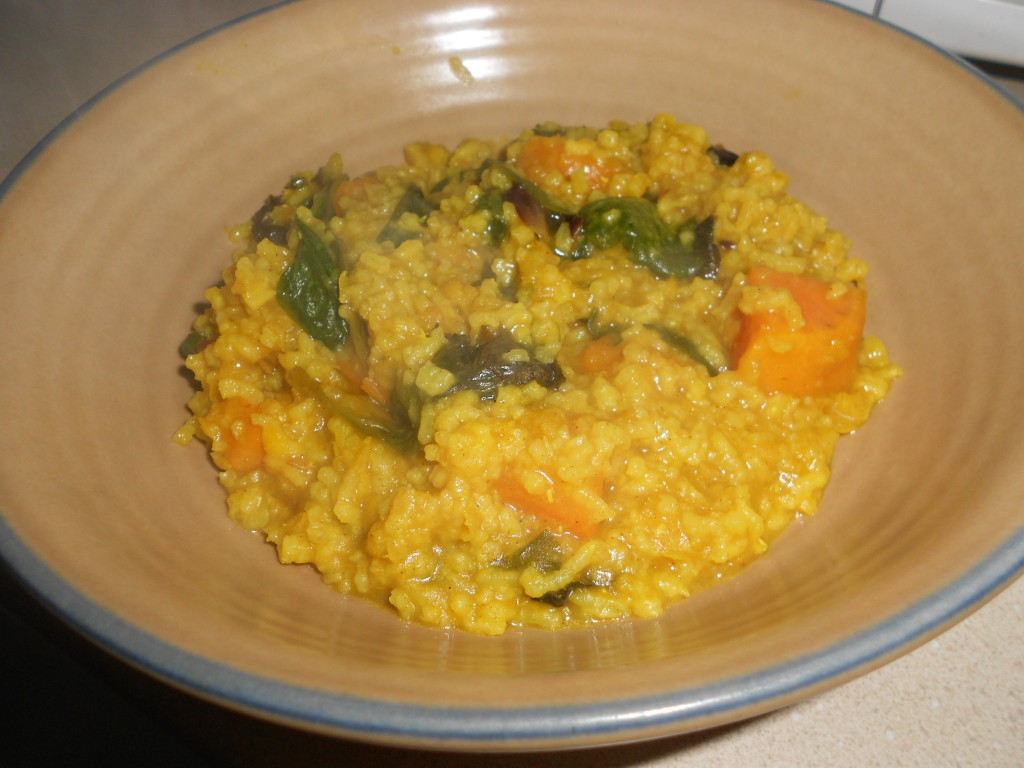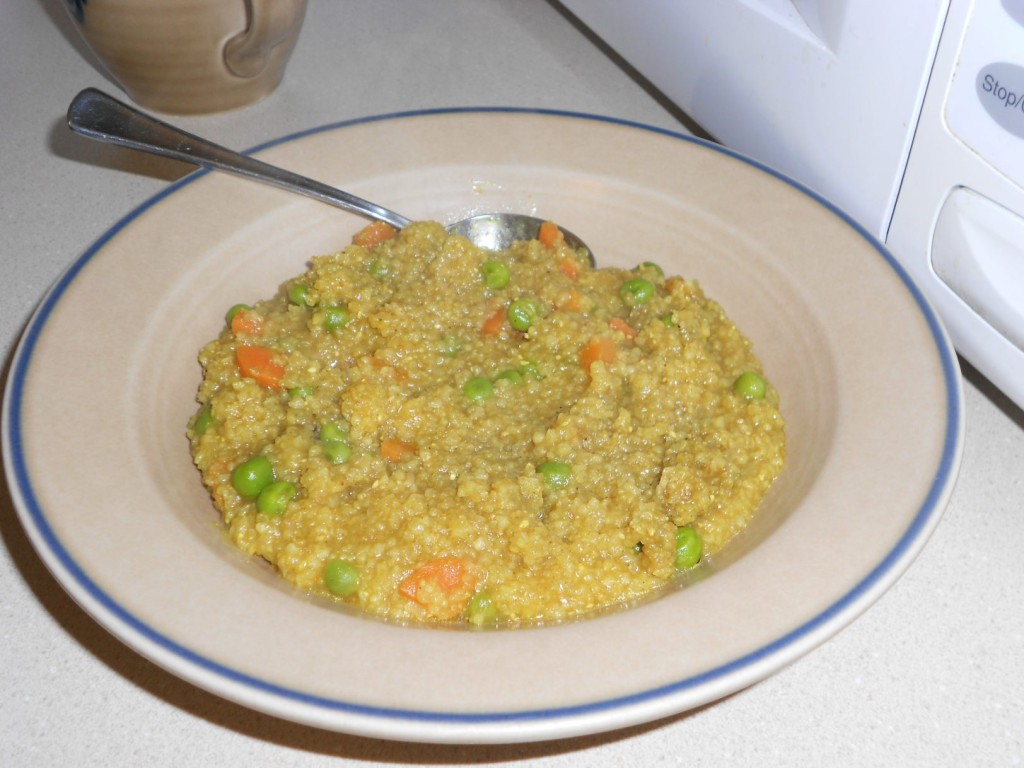Those of us with food sensitivities often are confronted with social food situations where we know “if I eat any of this, I’ll be sorry later” . . . but we want to be polite. So we pick the things that seem “relatively safe.” I’m pretty good at avoiding the likely culprits. And lucky for me, I won’t end up in the hospital if I am accidently exposed to gluten, dairy, or corn. But that doesn’t mean I won’t suffer: intestinal distress (gluten), sinus trouble (dairy), hives (corn).
My choice when I need to rebalance and cleanse my system is what I call Indian Comfort Food, two ayurveda-inspired porridges that soothe and restore: Kichari (aka kitchari, khichdi, and many other variations) and Savory Farina. Try one or both of these recipes and your body will thank you! (Recipes adapted from information obtained at an Ayurvedic Cooking class at Health Through Ayurveda.)
Kichari with Sweet Potato and Chard
Ingredients
- 1/2 cup split yellow lentils (moong dal) or red lentils (masoor dal)
- 1 cup white basmati or long-grain rice
- 6 cups boiling water
- 1-2 Tablespoons oil or ghee (I use coconut oil)
- 1 teaspoon cumin seeds
- 2 Tablespoons fresh ginger, grated
- 1 pinch baking soda
- 1 teaspoon ground cumin
- 1 teaspoon ground coriander
- 1 teaspoon turmeric
- 1 cinnamon stick (or 1/2 teaspoon ground cinnamon)
- 8 cloves (or 1/8 teaspoon ground cloves)
- 10-12 cardamom pods (or 1/4 teaspoon ground cardamom)
- 1 large sweet potato, peeled and chopped into bite-sized pieces
- 4 cups chard (swiss, red, or rainbow, about 1/2 bunch), stems removed, sliced or torn into bite-sized pieces
- Salt to taste
Directions
- Rinse split lentils until water runs clear. Soak 4 hours or overnight; drain and rinse.
- Get water boiling if it isn’t already.
- Warm oil in large sauce pan or Dutch oven. Add cumin seeds and ginger and sauté for 1 minute. Add drained lentils. Sauté for another few minutes. Add 4 cups of boiling water and pinch of baking soda. Bring to a boil and then turn down heat to low. Cover and simmer for 20 minutes.
- Meanwhile measure out remaining spices (cumin, coriander, turmeric, cinnamon, clove, cardamom), prepare sweet potato, and rinse rice.
- When beans are mostly cooked (after about 20 minutes), add rice and sweet potatoes. Add remaining 2 cups boiling water.
- In a separate small pan, heat 1 Tablespoon oil. Add spices. Warm over low heat just long enough to release aroma. Be careful not to burn. Add to bean/rice/sweet potato mixture.
- Continue cooking at a simmer until rice is done, 20-30 minutes, stirring occasionally.
- Add chard. Cook until greens are wilted and combined with the rest of the ingredients (5-10 minutes).
- Salt to taste.
- Enjoy!
[slideshow_deploy id=’1105′]
Notes
- The original recipe called for a pinch asafoetida (hing) added with the cumin seeds. I tried to find hing that didn’t also include gluten and/or corn starch. Unfortunately, my body reacted to the one product I found that said it was gluten-free in a way that told me there was something in it that I shouldn’t be eating . . . so even though this is a traditional “healling” ingredient in Indian/Ayurvedic cooking, I omit it.
- If you can’t find small split lentils, you may be tempted to use regular split peas (yellow or green). Unfortunately, those require MUCH longer to cook. I’m really not sure how to best modify this recipe to use them. There may be other kichari recipes on the web that use those larger split peas. (See slideshow above for a picture comparing the different types of lentils.)
- Kale, spinach, or other leafy greens can be substituted for the chard.
- Sometimes I heat all the spices at the beginning (with the cumin seed and ginger) rather than waiting until later. The flavor is a bit different and there’s a greater danger of burning the spices, but it can work (and leaves one less pan to wash and frees up one more burner).
- The original recipe claimed that this recipe “Serves 2-3.” I usually get 5-6 serviings out of it.
- [2021 update] I never figured out what the baking soda was supposed to be doing, so I now omit it and add 1/2 tsp of Ajwain instead. Ajwain is an Indian seed that “tempers the effects of a legume based diet” 🙂
Hearty Breakfast Farina (Uppma)
Ingredients
- 1 cup boiling water
- 1/4 cup brown rice farina (I use Bob’s Red Mill “Creamy Brown Rice Farina”)
- 1/2 cup vegetables (I use 1/4 cup finely chopped carrots and 1/4 cup frozen peas)
- 1-1/4 tsp Breakfast Spice Blend (see below) (OR 1/2 tsp coriander, 1/4 tsp cumin, 1/4 tsp turmeric, and 1/4 tsp cinnamon)
- 1 Tablespoon coconut oil or ghee
- Salt & Pepper to taste
Directions
- Start the water boiling in your kettle.
- In a small cast iron or non-stick pan over medium heat, lightly the brown rice farina, stirring frequently until the farina is light brown in color. Remove toasted farina to a bowl and set aside.
- Melt the coconut oil or ghee in the pan over low heat. Add the Spice Blend. Let spices warm for 10-15 seconds. Add vegetables and a small amount of water. Stir. Cover and cook vegetables for 5-7 minutes.
- When the vegetables are cooked, add the toasted farina and stir to coat.
- Add 1 cup boiling water and a dash of salt.
- Cook for approximately 5 minutes, stirring frequently as farina thickens.
- Enjoy with a cup of Chai Tea!
Breakfast Spice Blend (makes approx 1/4 cup, enough for 6 individual servings)
- 2 Tablespoons ground coriander
- 1 Tablespoon ground cumin
- 1 Tablespoon ground turmeric
- 1 Tablespoon ground cinnamon
Combine all the spices in a glass jar. Use 1-1/4 teaspoons (or a heaping teaspoon) for each serving.
Notes
I’ve only made this dish one serving at a time, but it should work if the ingredients are doubled/tripled/quadrupled. You might need to adjust water quantity, spice quantity, and/or cooking times.[2021 update] I now always double this recipe (so 2 cups water, 1/2 cup farina, 1 cup veggies, 2-1/2 tsp spice blend all in a slightly larger pan or sauce pan). Works fine and somehow doubling gives me 3 servings instead of two.- Other vegetable options: chopped onion, minced ginger, chopped yam or sweet potato, asparagus, leafy greens, or whatever else sounds good.
- I’m guessing this dish could be made with other grains (e.g., wheat farina or grits), but I haven’t tried that. You might have to adjust cooking times.
- [2021 update] I’ve also made the double recipe with 2 cups of leftover cooked rice instead of the farina (reduce the water). And I sometimes throw in a couple of scrambled eggs to make a really yummy Rice Bowl.
WOW! That’s quite a bit of information. Please let me know (in the comments) if anything needs clarification.




